

Suggestion: Watch context as you scan (album, box, bag), any clues as to what they are (unless you just know). Alternatively if you want it to grab them as you scan, you can set the auto-import feature. The simplest workflow by the way is to scan to a staging area, and then drag and drop those into LR. (Contrarily I hated Silverfast, but a lot of people love it - each to their own). well, kind of like I like Listerine - it works, sometimes I need it, but it sure tastes bad. I also struggle with VueScan each time I use it to really fine tune the colors, etc. I bought VS for negatives, though lately I've decided Negative Lab Pro works better for them, at least it is easier to get good results. I also found that the dustoff in Epson was worth using (despite being positives) but nothing else, everything else I could do better in Photoshop or Lightroom (color balance, etc.).
#VUESCAN WORKFLOW HOW TO#
I could not figure out how to make VueScan do that it seems limited to doing that only for specific negatives and similar in a specific aspect and arrangement. I spent some time experimenting with Epson's Scanning app that came with my scanner (not sure what scanner you have?) and I found it easier to use and just as good, especially when I put a collage of photos on the flatbed, it would find all the edges. Any thoughts about VS's features or links to information about them would be greatly appreciated. Scanning old photos is not an area where I have a lot of prior experience, and I am not sure that I have the wherewithal to fully figure this out on my own in any reasonable amount of time. Some of VS's features could be the next best thing to sliced bread, then again they might not hold a candle to what LR can offer.

So, my questions revolve around how much do I want VS to process the master files during scanning? Are there adjustments or corrections that are better done in VS during the scanning process than in LR afterwards? Or should I leave it to LR to do most of the heavy lifting? I know that VS has quite a following, but there is no official forum that I could find and I have yet to find any information on the web that discusses the program's many features in any depth. Reprocessing them later is LR would be fine, but I prefer not to have to re-scan if possible. My other objective is to do the best scanning job that I can (given the material that I am working with) so that I do not find myself wanting to re-scan the images down the road.

I plan on cleaning the files up as time permits, but I do not necessarily have plans at this time for any extensive restoration. My objective is to scan a 16-bit TIFF master copy that I can import into a LR catalog and then export out any derivatives as needed (e.g. Having said that, I will still be using it to run a flatbed scanner to scan a large number of old photographs (no negatives or transparencies as those will be handled with different hardware).
#VUESCAN WORKFLOW FULL#
Little of it is user friendly, and it left me with more questions than answers after doing a full pass on the entire file. I applaud Ed for providing a detailed guide for VS, but it leads me to believe that it was written for an audience of one - Ed himself.

#VUESCAN WORKFLOW PDF#
I have just finished the 100+ page PDF User's Guide to VueScan (VS) and was again reminded why I have had a love/hate relationship with this software over the years.


 0 kommentar(er)
0 kommentar(er)
